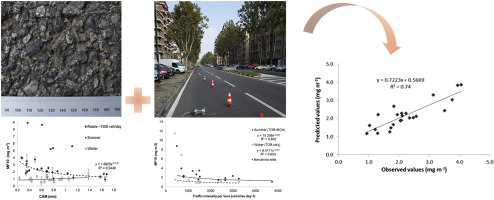Environmental Pollution ( IF 8.9 ) Pub Date : 2017-11-09 , DOI: 10.1016/j.envpol.2017.10.115 Elio Padoan , Franco Ajmone-Marsan , Xavier Querol , Fulvio Amato

|
The relative impact of non-exhaust sources (i.e. road dust, tire wear, road wear and brake wear particles) on urban air quality is increasing. Among them, road dust resuspension has generally the highest impact on PM concentrations but its spatio-temporal variability has been rarely studied and modeled. Some recent studies attempted to observe and describe the time-variability but, as it is driven by traffic and meteorology, uncertainty remains on the seasonality of emissions. The knowledge gap on spatial variability is much wider, as several factors have been pointed out as responsible for road dust build-up: pavement characteristics, traffic intensity and speed, fleet composition, proximity to traffic lights, but also the presence of external sources. However, no parameterization is available as a function of these variables.
We investigated mobile road dust smaller than 10 μm (MF10) in two cities with different climatic and traffic conditions (Barcelona and Turin), to explore MF10 seasonal variability and the relationship between MF10 and site characteristics (pavement macrotexture, traffic intensity and proximity to braking zone). Moreover, we provide the first estimates of emission factors in the Po Valley both in summer and winter conditions. Our results showed a good inverse relationship between MF10 and macro-texture, traffic intensity and distance from the nearest braking zone. We also found a clear seasonal effect of road dust emissions, with higher emission in summer, likely due to the lower pavement moisture. These results allowed building a simple empirical mode, predicting maximal dust loadings and, consequently, emission potential, based on the aforementioned data. This model will need to be scaled for meteorological effect, using methods accounting for weather and pavement moisture. This can significantly improve bottom-up emission inventory for spatial allocation of emissions and air quality management, to select those roads with higher emissions for mitigation measures.
中文翻译:

基于路面和交通特性预测道路粉尘排放的经验模型
非排放源(即道路灰尘,轮胎磨损,道路磨损和刹车磨损颗粒)对城市空气质量的相对影响正在增加。其中,道路扬尘的悬浮通常对PM浓度的影响最大,但其时空变异性却很少被研究和建模。最近的一些研究试图观察和描述时变性,但是由于它是由交通和气象学驱动的,因此排放的季节性仍然存在不确定性。关于空间变异性的知识鸿沟要大得多,因为已经指出造成道路扬尘的几个因素:路面特性,交通强度和速度,车队组成,与交通信号灯的距离以及外部环境的存在。但是,没有参数化可作为这些变量的函数。
我们在两个气候和交通状况不同的城市(巴塞罗那和都灵)调查了小于10μm(MF10)的移动道路灰尘,以探讨MF10的季节变化以及MF10与站点特征(路面宏观纹理,交通强度和靠近刹车的距离)之间的关系。区)。此外,我们提供了夏季和冬季条件下Po Valley排放因子的初步估算。我们的结果表明,MF10与宏观纹理,交通强度和距最近制动区的距离之间具有良好的反比关系。我们还发现道路粉尘排放具有明显的季节性影响,夏季排放较高,这可能是由于路面湿度较低所致。这些结果使我们可以建立一个简单的经验模式,预测最大的粉尘负荷,从而预测潜在的排放量,根据上述数据。需要使用考虑天气和人行道湿度的方法来缩放此模型的气象效果。这可以显着改善自下而上的排放清单,以进行排放物的空间分配和空气质量管理,以选择排放量更高的道路作为缓解措施。


























 京公网安备 11010802027423号
京公网安备 11010802027423号